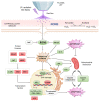Cold Atmospheric Plasma: A New Strategy Based Primarily on Oxidative Stress for Osteosarcoma Therapy
- PMID: 33672274
- PMCID: PMC7926371
- DOI: 10.3390/jcm10040893
Cold Atmospheric Plasma: A New Strategy Based Primarily on Oxidative Stress for Osteosarcoma Therapy
Abstract
Osteosarcoma is the most common primary bone tumor, and its first line of treatment presents a high failure rate. The 5-year survival for children and teenagers with osteosarcoma is 70% (if diagnosed before it has metastasized) or 20% (if spread at the time of diagnosis), stressing the need for novel therapies. Recently, cold atmospheric plasmas (ionized gases consisting of UV-Vis radiation, electromagnetic fields and a great variety of reactive species) and plasma-treated liquids have been shown to have the potential to selectively eliminate cancer cells in different tumors through an oxidative stress-dependent mechanism. In this work, we review the current state of the art in cold plasma therapy for osteosarcoma. Specifically, we emphasize the mechanisms unveiled thus far regarding the action of plasmas on osteosarcoma. Finally, we review current and potential future approaches, emphasizing the most critical challenges for the development of osteosarcoma therapies based on this emerging technique.
Keywords: cancer stem cells; cold atmospheric plasma; osteosarcoma; oxidative stress; plasma treated liquids; reactive oxygen and nitrogen species; tumor microenvironment.
Conflict of interest statement
The authors declare that they have no competing interests.
Figures





Similar articles
-
Osteosarcoma tissue-engineered model challenges oxidative stress therapy revealing promoted cancer stem cell properties.Free Radic Biol Med. 2021 Feb 20;164:107-118. doi: 10.1016/j.freeradbiomed.2020.12.437. Epub 2021 Jan 2. Free Radic Biol Med. 2021. PMID: 33401009 Free PMC article.
-
Cold plasma and inhibition of STAT3 selectively target tumorigenicity in osteosarcoma.Redox Biol. 2023 Jun;62:102685. doi: 10.1016/j.redox.2023.102685. Epub 2023 Mar 20. Redox Biol. 2023. PMID: 36989573 Free PMC article.
-
Cold Atmospheric Plasma in the Treatment of Osteosarcoma.Int J Mol Sci. 2017 Sep 19;18(9):2004. doi: 10.3390/ijms18092004. Int J Mol Sci. 2017. PMID: 28925941 Free PMC article. Review.
-
Dose-Dependent Effects of Cold Atmospheric Argon Plasma on the Mesenchymal Stem and Osteosarcoma Cells In Vitro.Int J Mol Sci. 2021 Jun 24;22(13):6797. doi: 10.3390/ijms22136797. Int J Mol Sci. 2021. PMID: 34202684 Free PMC article.
-
Plasma-Conditioned Liquids as Anticancer Therapies In Vivo: Current State and Future Directions.Cancers (Basel). 2021 Jan 25;13(3):452. doi: 10.3390/cancers13030452. Cancers (Basel). 2021. PMID: 33504064 Free PMC article. Review.
Cited by
-
Anticancer and Antioxidant Activity of Water-Soluble Polysaccharides from Ganoderma aff. australe against Human Osteosarcoma Cells.Int J Mol Sci. 2022 Nov 26;23(23):14807. doi: 10.3390/ijms232314807. Int J Mol Sci. 2022. PMID: 36499132 Free PMC article.
-
Cold atmospheric plasma enhances morphological and biochemical attributes of tomato seedlings.BMC Plant Biol. 2024 May 18;24(1):420. doi: 10.1186/s12870-024-04961-5. BMC Plant Biol. 2024. PMID: 38760701 Free PMC article.
-
Rethinking Antigen Source: Cancer Vaccines Based on Whole Tumor Cell/tissue Lysate or Whole Tumor Cell.Adv Sci (Weinh). 2023 Aug;10(22):e2300121. doi: 10.1002/advs.202300121. Epub 2023 May 31. Adv Sci (Weinh). 2023. PMID: 37254712 Free PMC article. Review.
-
Possible Synergies of Nanomaterial-Assisted Tissue Regeneration in Plasma Medicine: Mechanisms and Safety Concerns.Nanomaterials (Basel). 2022 Sep 28;12(19):3397. doi: 10.3390/nano12193397. Nanomaterials (Basel). 2022. PMID: 36234523 Free PMC article. Review.
-
Construction of a 5-gene prognostic signature based on oxidative stress related genes for predicting prognosis in osteosarcoma.PLoS One. 2023 Dec 1;18(12):e0295364. doi: 10.1371/journal.pone.0295364. eCollection 2023. PLoS One. 2023. PMID: 38039294 Free PMC article.
References
-
- Spraker-Perlman H.L., Barkauskas D.A., Krailo M.D., Meyers P.A., Schwartz C.L., Doski J., Gorlick R., Janeway K.A., Isakoff M.S. Factors influencing survival after recurrence in osteosarcoma: A report from the Children’s Oncology Group. Pediatr. Blood Cancer. 2019;66:e27444. doi: 10.1002/pbc.27444. - DOI - PMC - PubMed
Publication types
Grants and funding
LinkOut - more resources
Full Text Sources
Other Literature Sources

